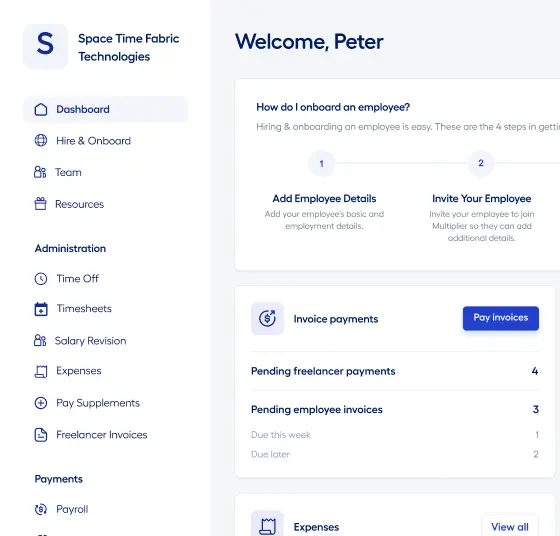There was a time when international expansion was only possible for the largest companies. But, with rapid advancements in technologies that enable remote work, companies are now empowered to hire much more easily from the global talent pool.
To successfully tap into the rich seam of global workers, however, you first need to know how to pay them. In this blog, we’ll explore the nitty-gritty of payroll for a global workforce.
Understanding international employee payment options
It’s vital to understand the nature of an employee’s job when considering how to pay them, as it will likely affect the decision of payment method.
That said, let’s begin by looking at four straightforward, no-nonsense ways to pay your international employees.
1. Pay them as independent contractors
One option to avoid the headaches of managing tax and compliance is to classify your overseas workers as independent contractors. Since contractors must deal with local taxes and benefits on their own, the responsibilities of the hiring company are significantly reduced.
This model undoubtedly works well for certain types of positions or projects. For instance, global workers in specialist roles, such as consultants or lawyers, are very suited to being paid as independent contractors.
But that doesn’t mean businesses can go around treating all their workers as contractors willy-nilly. It’s essential to understand the nuances separating an employee from a contractor or face penalties for misclassification.
While the specifics vary between jurisdictions, when you employ a worker with a specialized set of skills for short-term projects under a written contract or verbal agreement, you can classify them as an independent contractor.
2. Use a global payroll provider
Partnering with a global payroll provider like Multiplier is the simplest way of managing overseas employee salaries.
Multiplier’s global payroll solution sidesteps the desperate search for local payroll vendors, the stress of managing multiple systems, and the headache of juggling currencies and regulations.
Instead, it lets you consolidate and streamline payroll operations across multiple countries in one fully compliant platform and gives you total transparency and insights into budgets.
By working with a global payroll provider like Multiplier, you can be sure of compliance with international and local laws without establishing legal entities in the countries you hire from.
3. Pay the employee on your home country’s payroll
If an employee is assigned short-term work overseas, you might still be able to pay them via the usual payroll.
Such an approach is obviously attractive due to the minimal administrative effort involved. Not all countries allow it, however, so check with your local government laws to understand the feasibility of this option.
However, suppose you are hiring an employee resident in another country. In that case, paying them this way isn’t a legal option because the individual must pay taxes and make other contributions to their own country—meaning a separate payroll is required.
4. Ask a local partner or third-party company to place them on their payroll
There’s no one single way of running a global business. A company whose workers all reside in the business’ home country can still operate across the globe—in which case there is no need for special pay arrangements. Equally, the country your company is incorporated in could have very few workers, with the rest spread to every corner of the globe.
Or, consider the case where your foreign employees are all in one single country other than the one your company is based in. In that case, it could be wise to partner with a local company to serve as their official employer. That way, the partner takes care of payroll, benefits, taxes, contracts, and so on, with the original company simply remitting the cost of salaries to the partner, who then distributes it to workers.
Sounds simple enough. The problem is finding a trustworthy foreign company to partner with. More to the point, if you subsequently decide to hire global workers in new locations, you’ll have to partner with more and more companies, taking up valuable time and resources.
Developing effective global payroll strategies
OK, so those are the options. While paying employees in different countries from your home country, however, more than a few challenges are bound to appear along the way. Overcoming them requires acting strategically. Here are a few tips to keep you on the straight and narrow.
1. Currency
Currency fluctuations are a fact of life for global businesses. Employees in foreign countries are likely to use different currencies, meaning businesses must be hyper-aware of the costs of currency exchange fees and constantly changing rates.
Without careful management, the ups and downs of currencies can lead to difficulties assigning the correct budget—or even the nightmare scenario of insufficient money to pay employees. Of course, such things are automatically taken care of with Multiplier’s Global Payroll.
2. Taxes and other obligations
As mentioned earlier, taxes are another thorny issue when paying international employees. Paying foreign employees means double-checking tax laws in different countries to ensure everyone gets their due.
Depending on local laws and international treaties, some employees may be doubly taxed (once in their own country and once in the country that hosts the business). Employers need, therefore, to carefully evaluate the costs of hiring an individual before sending an employment contract to an international employee.
3. Payment methods
Direct deposits to their bank? Wire them? How about a digital wallet? There’s no shortage of options when it comes to cross-border employee compensation, so much so that it can be hard to choose the right one.
A business’ decision should be based on several factors, such as fees, processing time, flexibility, and just simple availability in the target country.
4. The problem with entities
It’s also possible to set up business entities abroad to facilitate the payment of employees abroad—but there’s a lot of work involved, from choosing a legal structure to filing the right paperwork. A popular option for unlocking the benefits of this approach without all the hassle is via an employer of record.
Engage an Employer of Record (EOR) | Get the Multiplier Advantage
With the rapid advancements in remote technology catalyzed by cloud computing, cybersecurity, video conferencing platforms, etc, SaaS-based EOR or an Employers on Record will be all the rage. The solutions are also within the law while paying overseas workers.
Many overseas companies benefit from EOR solutions ( in the case of Multiplier, 50+).
According to the law, the entity that pays the worker takes legal responsibility and accountability for the employee. EORs are companies that can take employees under their payroll and manage administrative activities efficiently, thus, effectively making employees their legal responsibility.
Delegating your employee’s payroll to your EOR partner enables you to impart functions such as processing payroll, dealing with government bodies, ensuring tax compliance, or filing paperwork to the EOR
Also, a SaaS-based EOR like Multiplier would already possess the infrastructure to pay international employees. They would:
- Posses locally registered entities
- Local bank accounts
- Automate generating employment contracts
More emphatic EORs like Multiplier – which understand the nuances of HR such as employee experience, engagement, and retention – also help in imparting benefits such as insurance for contractors and full-time international employees.
Simply put, an EOR quickly and easily eliminates the barriers to entry in global markets. They can also open doors to foreign markets and in the case of Multiplier, we help you enter new markets in 24-48 hours. We help you protect your company while paying international employees. By promptly handling administrative tasks, you can focus on your expansion efforts.
Interested to know more? Book a call with Multiplier.
Frequently asked questions about paying international employees
Q. How can I manage global payroll?
Well, there’s the hard way and the easy way. The hard way involves setting up your entities everywhere your global workers are based and managing the local nuances (like taxes, insurance contributions, etc.) yourself. Or, you could hire workers through an employer of record like Multiplier, who takes care of it all for you!
Q. Can I hire workers from anywhere?
In Multiplier’s case, pretty much! Our solution lets you onboard talent in over 170 countries worldwide. Moreover, you can pay them in more than 120 currencies with just a single click.
Q. How do I calculate global taxes?
With great difficulty! As we’ve mentioned, tax laws vary hugely from jurisdiction to jurisdiction. If you’re keen to solve the problem yourself, expect a mountain of research and voluminous spreadsheets.







